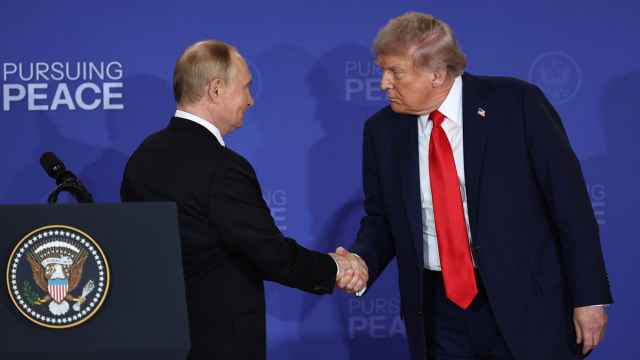The optimist will tell you that Russia is no longer a petrostate. Incremental growth is now coming from the consumer sectors, while there is less contribution from the oil-and-gas sector. While the budget clearly does depend on the volume of oil and gas revenues to balance, changes by the Central Bank and the Finance Ministry since the 2008 crisis mean the economy can still grow about 3 percent annually with much lower oil revenues because the resulting budget deficit can be easily covered by expansion of the low debt load. But the realist will say that while growth is coming from outside extractive industries, the confidence factor, which sustains consumer spending and domestic investment, is directly linked to oil revenues. What's more,the practice of funding the budget via debt expansion can last for only a few years.
So long as the government delays making the tough decisions necessary to push ahead with the agenda of business and economic reform, it is only a matter of time before the next crisis comes as a result of lower oil prices. The basis of the next crisis is already visible. It is the steady and significant growth in the production of nonconventional oil and gas in the U.S. For the world's traditional oil and gas producers, like Russia, a big storm is coming. Based on current projections of rising U.S. production and the effect this will have on global oil market dynamics, that storm will start to blow very strongly in 2014 or 2015 at the latest.
Russia is a member of an exclusive club of countries that boast meaningful economic growth and healthy balance sheets and have surpluses in both their budgets and their current accounts. Despite the slower growth reported for the third quarter and the weaker trend reported earlier this week, the economy should deliver between 3.5 and 4 percent growth in gross domestic product this year in some of the consumer indicators for October. That is more than twice the growth rate expected for the group of developed economies and is in line with the average growth expected for developing economies outside of the Asia region.
Therefore, Russia should be a safe place for investors, and the stock market should be benefiting from the fact that the country has low relative risk. But this is not the case. When you look at such investor sentiment indicators as the underperformance of Russian equity-market indexes, the current valuation of Russian equities and the low volume of investor money coming into the country this year, the picture reflects a high level of investor concern. The government may be willing to take the bet on high sustainable oil revenues, but investors are not.
The main reason for investor's concern is oil, specifically the fear that Russia's government is not doing enough to diversify the economy away from oil risk against a backdrop of uncertainty over the future of traditional energy markets. One reason for that uncertainty is the fast growth in supply of nonconventional oil and gas, mainly shale oil and gas from the U.S. Other factors include planned production increases in the Canadian sands, growth of conventional oil output in Iraq and the expected start of Kazakhstan's Kashagan oil field in early 2013. That doesn't even factor in the possible growth in shale gas across Europe. That supply source is currently blocked because of environmental concerns, but the reasonable assumption is that those concerns will be eased once the U.S. starts to benefit from the competitive advantage of cheap domestic energy.
The expected growth in U.S. oil and gas supply is the most serious concern for Russia and other leading energy exporters. The U.S. currently burns almost 20 million barrels of oil per day, or just over one-fifth the world total. To feed that requirement, the country needs to import about 11 million barrels of crude every day, mainly from the Middle East. But with domestic supply of nonconventional oil increasing and more consumers switching to cheap gas, the U.S. import requirement has already begun to fall. Several years ago, the country needed to import more than 12 million barrels of oil per day. By the end of next year, that is expected to fall to 10 million barrels per day. What's more, according to a recent study from the International Energy Agency, the U.S. may become completely energy-independent within two decades.
No matter how you look at those numbers, the growth in supply of nonconventional oil and gas is a game-changer for the global oil industry. The long-term outlook from the International Energy Agency assumes that the decline of the U.S. as the world's major buyer of crude will be matched with continued growth in demand from China, India and the Middle East. Hence the agency's conclusion that the price of oil can still reach $125 per barrel in real terms by the end of this decade. That is $215 per barrel in nominal terms. If that does actually turn out to be the case, Russia will remain in good economic shape, albeit without progress in reforming the economy and improving the business environment. Meanwhile, growth will stay stuck in a narrow range around 3 percent annually, which is above average for developed countries over the past few years but below average for developing countries.
The reasons investors are still nervous about Russia oil risk despite rosy price forecasts is that long-term oil projections have almost always been wrong. Historically, it has often been more profitable to take the view that is the opposite of the industry consensus. The fear of so-called peak oil, when the world no longer has enough incremental supply to satisfy growing demand, has been a regularly forecast event over the past 60 years and frequently drove prices higher. But in 2000, we had headlines suggesting that the world was "drowning in oil," and analysts were projecting prices at $8 per barrel.
Relying on long-term oil projections is inherently dangerous. But that is exactly what the Russian government is doing. By delaying reforms, the country is relying on the International Energy Agency's price and demand projections and assuming that the storm clouds now gathering in the U.S. will dissipate. China, India and the rest of Asia will have to continue growing annual oil imports by more than 1 million barrels per year for the next 10 years to compensate for the expected cut in U.S. imports and the growth in supply from Iraq and elsewhere. That is nothing short of wagering future economic growth by rolling the dice in a game where nonconventional oil and gas are changing the odds.
Chris Weafer is chief strategist at Sberbank Investment Research.
Related articles:
A Message from The Moscow Times:
Dear readers,
We are facing unprecedented challenges. Russia's Prosecutor General's Office has designated The Moscow Times as an "undesirable" organization, criminalizing our work and putting our staff at risk of prosecution. This follows our earlier unjust labeling as a "foreign agent."
These actions are direct attempts to silence independent journalism in Russia. The authorities claim our work "discredits the decisions of the Russian leadership." We see things differently: we strive to provide accurate, unbiased reporting on Russia.
We, the journalists of The Moscow Times, refuse to be silenced. But to continue our work, we need your help.
Your support, no matter how small, makes a world of difference. If you can, please support us monthly starting from just $2. It's quick to set up, and every contribution makes a significant impact.
By supporting The Moscow Times, you're defending open, independent journalism in the face of repression. Thank you for standing with us.
Remind me later.








